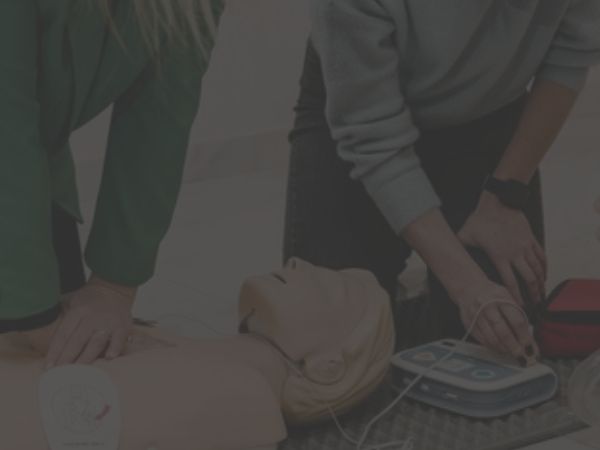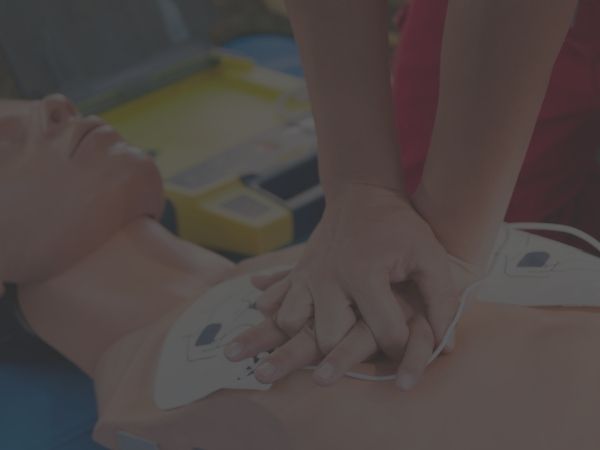Your cart is currently empty!
How to Get Ready for the New CMS Rule for Emergency Preparedness
ONE OF THE GRAVEST THREATS facing the U.S. today is the risk of wildfires and natural disasters. While many associate wildfires and natural disasters with the Federal Emergency Management Agency (FEMA), you must not overlook the role health care organizations play in successful emergency management. Take a moment to think about your organization’s emergency preparedness plan.
Health care organizations are responsible for creating, managing and maintaining emergency preparedness plans under the guidance and direction of the Centers for Medicare and Medicaid Services (CMS). However, emergency preparedness remains a topic of constant change.
 As explained in the previous blog post, a Code Green designates activation of the emergency preparedness plan. Yet, the standards for emergency preparedness are changing again later this year. Failure to update your emergency preparedness plan could result in penalties levied by CMS, problems working with insurers, financial setbacks and a lack of coordination and response if an emergency occurs.
As explained in the previous blog post, a Code Green designates activation of the emergency preparedness plan. Yet, the standards for emergency preparedness are changing again later this year. Failure to update your emergency preparedness plan could result in penalties levied by CMS, problems working with insurers, financial setbacks and a lack of coordination and response if an emergency occurs.
Consequently, you need to understand the new CMS ruling’s impact on emergency preparedness regulations, how it impacts the success of your organization and why knowing its fundamentals are essential to coordination during an emergency.
What Is the Emergency Preparedness Rule?
The emergency preparedness rule is designed to ensure “adequate planning for both natural and man-made disasters,” reports CMS. To date, emergency preparedness has been up to individual organizations to define. However, the fundamentals of the new rule require each organization to create or update its own set of emergency preparedness regulations and submit documentation to CMS.
In addition, all facilities and organizations must demonstrate compliance the emergency preparedness rule no later than November 16, 2018. In addition, any local or state regulations that supersede the minimum requirements in the new rule will remain in effect in each jurisdiction. Therefore, your organization should check with your state’s governing body to determine if any additional changes are required.
Why Is the New Rule Being Put Into Effect?
This is the obvious question. If health care organizations already have existing policies and procedures in place for emergency preparedness, why is CMS implementing this new rule? The answer lies in past CMS survey results.
Surveys from recent years suggest the minimum standards to ensure the safety and longevity of patients in organizations receiving funding, in whole or in part, from CMS were not being met. Furthermore, the regulatory requirements in existence did not necessarily define a set expectation for patient safety, coordination or response during emergencies, asserts Jeff Lagasse of Healthcare Finance.
An example, the immense flooding and terrible consequences of flooding in Baton Rouge in 2016 or the raging wildfire of Bastrop, Texas in 2011 alluded to a failure to plan for events thought to be “nearly impossible.”
The key to understanding the concept is in the wording, “nearly impossible.” These major emergencies of the last decade demonstrated the ineffectiveness of existing regulations, including failure to plan for emergencies believed unlikely to occur.
Some providers and health care organizations have advanced, detailed emergency preparedness plans, policies and procedures in place. However, these organizations are not exempt from the new rule.
Regardless of your organization’s role or earlier achievements, you must review all existing policies and procedures for adherence to the new standards and best practices set forth within the rule.
Specifically, the new rule eliminates the possibility of failure to meet current CMS regulations for emergency preparedness. The new rule incorporates four best practices that all CMS participants must meet and use in the development of new policies and procedures, discussed in the next section.
One of the major factor in these practices is universal application and continuous improvement. Most importantly, every employee, contractor or other person working or performing a service, including volunteering, within your organization must understand the new rule and complete required, routine and standardized training and testing to verify such understanding. Of course, any new rule is about much more than its four guiding principles.
What Are the Components of the New Rule?
There are four primary components found within the new rule. These include the following:
- Immediate creation of an emergency plan based on disaster risks and likelihood of occurrence.
- The creation of an all-hazards approach to emergency preparedness, such as creating flood disaster preparedness plans in areas that have never experienced or are not likely to experience a flood.
- The development of a plan for maintaining communications with both federal and state authorities.
- The creation or execution of emergency preparedness training, drills and exercises, including documentation practices for training and testing to verify understanding of changes or policies within the new rule.
Who Will the New Rule Impact?
The new rule impacts the 17 provider types identified by CMS. These include the following:
- Hospitals
- Ambulatory surgical centers.
- Hospices and hospice agencies.
- Psychiatric facilities, including inpatient and outpatient facilities.
- Transplant facilities.
- Long-term care facilities.
- Intermediate care facilities for those with intellectual or developmental disabilities (IDD).
- Home health agencies.
- Outpatient rehabilitation facilities.
- Mental health centers, serving communities or religious-affiliated groups.
- Rural health clinics.
- Facilities providing services to End-Stage Renal Disease patients.
- Organ procurement organizations.
- All-inclusive care for the elderly, including skilled nursing facilities.
- Outpatient rehabilitation facilities, like physical therapy centers.
- Clinics, rehabilitation agencies and public health agencies acting as outpatient providers of therapy.
- Religious nonmedical home care institutions.
Certain facilities may not be impacted by the new rule; however, these facilities should not underestimate their role in providing emergency services or preparedness plans under local or state statutes.
For example, dedicated surgical centers staffed exclusively for plastics or reconstructive surgeries, provided they do not receive any federal funds, may be excluded from the list of entities described by CMS.
Who Oversees the New Rule?
CMS is responsible for overseeing the implementation and adherence to the new rule. This is due to the agency’s ease in communication and existing communication channels with individual providers and health care organizations. But, some organizations, such as the surgical center mentioned that does not fall within the 17 provider types, may still be subject to oversight by CMS.
This occurs as many health care facilities receive annual health and safety inspections at the direction of CMS for local, state or federal licensing purposes. In other words, all health organizations should consider re-evaluating existing emergency preparedness plans and assessing risks not previously considered.
Another factor impacting facilities revolves around facility transfer agreements. Facility transfer agreements must also dictate all appropriate considerations and measures required between two cooperating health providers in the event of a disaster requiring the transfer of patients to an alternate care facility.
The agreement is a legal, binding document, so it must cover all specifications and standards required by the receiving and sending facility. In fact, CMS has a sample agreement available online for ensuring new agreements drafted in response to the new ruling adhere to standard criteria, including its four elements.
Penalties for Non-Compliance?
The penalties for non-compliance under the new rule are simple. An organization’s failure to complete necessary paperwork, re-evaluation, risk assessment and planning by November 16, 2018 may be subject to the typical penalties levied by CMS. This includes revocation of participation with the Medicare or Medicaid program, immediate suspension of ability to offer services to patients with existing health coverage under the programs or financial penalties in the form of revocation and demand for repayment of financial incentive program monies gained through CMS.
These penalties are not unlike the financial penalties assessed among facilities experiencing consistent or repeated failures to provide adequate health services and ensure minimum complications.
CMS now has the tools and resources in its grasp to track patient outcomes and issues, like hospital-acquired infections (HAIs). These same tools will be used by the organization to monitor performance and upkeep of new emergency preparedness standards. Obviously, true measurements of responsiveness will be unavailable unless your organization finds itself in the middle of a disaster. However, measurement scores will be assessed by the Quality Measure and Value-Based Incentive Group via CMS for compliance with policy review, re-evaluation, alteration and enactment.
This is really a straightforward way of saying, “If you do not make your efforts to comply, your organization will suffer financial setbacks and penalties.”
What Should Providers Do to Prepare Now?
CMS provides extensive direction for all specific provider types regarding the four tenants of the new rule. With few exceptions, most providers must meet all emergency preparedness requirements, including developing a plan using the “all-hazards” approach, developing policies and procedures, developing communications plans and implementing and maintaining a strict testing plan.
Health care organizations providing continuous services or care measures requiring the use of electricity to sustain life, like hospitals or home health agencies providing intensive care in the home setting, must also implement policies to guarantee such equipment’s continuous operation. In other words, generators, emergency light and alarm systems must be in place.
The information listed by CMS can also appear incredibly difficult to apply in your new emergency preparedness plans, especially for facilities and organizations with extensive, existing plans and policies in place. As a result, use this quick list of steps to help your organization prepare for the new rule and ensure maximum compliance by 2018 deadline.
Evaluate Current Plan.
First, your organization needs to pull all existing policies and procedures surrounding emergency preparedness. Create a team to manage the policy review and enhancement process.
The team should include supervisory staff members from every department in your facility. Furthermore, departments that do not have a direct supervisor per unit within the same care certification, like certified nursing assistants, should also contribute at least one member to the team. This will help create a cohesive view of the possible risks and issues present in revisiting and creating new emergency preparedness plans.
In addition, it may be advisable to break the team into individual groups to work on specific goals and needs that fall within their department’s duties in the event of an emergency.
For instance, dietary supervisors should be included to ensure meals are still prepared in the event of an unforeseen emergency, even if it means outsourcing additional services to other agencies or companies.
Moreover, all personnel involved in the team should have an extensive background in the field and an understanding of existing company policies or procedures for emergency preparedness.
Review Existing CMS Resources.
Next, have all team members, especially administrative officials review all documentation listed on the CMS website for enactment of the new rule. This includes the breakdown of organizational responsibilities for the 17 provider types and the PDF file of all-hazards identified by CMS that could contribute to or be directly impacted in the event of an emergency.
Another excellent tool to review includes the existingSurvey and Certification criteria within CMS emergency preparedness guidelines. This six-page checklist provides an effortless way of ensuring your organization complies and meets all criteria under the new rule. Furthermore, it promotes accountability in the process, and it may be useful for submitting new policies and procedures to CMS at the time of survey when the new compliance rule goes into effect.
Determine Requirements for Your Facility.
Determine how the requirements will impact your facility. This is based on what provider type you are considered and the level of care you provide. All requirements should be detailed, not unlike a medical textbook, emphasizing what practices should and should not be implemented.
The requirements should also be broken down into charts to reflect individual department needs and possible solutions to each risk. Speaking of risks, these charts should be further refined to include needs and requirements that may become evident for specific risks. While the amount of paperwork involved may seem extreme, it will make the process easier when creating a final set of policies and procedures for emergency preparedness in your facility. Also, it will ensure consistency when implementing training and testing among your staff.
Implement Strong EHR If Not in Place.
Paper records are a nightmare and susceptible to extreme loss or damage in the event of a disaster. Think of the fires in times of drought. Your organization may not have the time necessary to save all patient information, test results, treatments and records. However, an electronic health records (EHR) system can mitigate this risk.
If your organization has not yet implemented an EHR system, you need to do so immediately. In fact, electronic records are a best practice identified by CMS, and since CMS remains the governing agency for the implementation of the new rule, it can be inferred as a requirement in the current rule. Obviously, it is still possible to meet the new rule’s requirements while still using paper records. However, it will make surviving and overcoming a disaster much more challenging and financially draining on your organization than necessary.
Consider Rural and Urban Areas Near Your Organization Impacted by Disasters.
Rural and urban areas reflect some of the biggest challenges in creating emergency preparedness plans. Rural health organizations may provide services to extensive regions and thousands of square miles. However, urban areas, while serving a smaller physical area, may serve tens of thousands of patients in a week or month. Therefore, your organization should consider your proximity to both urban and rural areas and the various disasters that may evolve in the future. Additionally, it may be necessary to draft and executive facility transfer agreements with other organizations in areas unlike yours.
For example, if your organization serves a rural area, you should have plan in place for working with urban health organizations in the event of a disaster that impacts all organizations in the immediate vicinity of your physical location.
You must also determine what minimum care standards, equipment, medications and devices should be present in alternate care facilities to ensure the safety and longevity of those you serve.
For example, home health agencies serving patients with end-stage renal failure should work to create a network of dialysis sites accessible in the event of an emergency.
Consider the Impact of Emergency Access to Resources.
A disaster is not something people commonly plan about. Yes, people may plan for fires or other disasters, but wide-scale disasters, like floods or fires, can result in chaos. Meanwhile, the demand on emergency facilities increases exponentially when a disaster strikes. Thus, your organization should consider emergency services, even if you do not routinely provide them, as an extension of your own facility’s resources. Moreover, all health organizations should create a standard facility transfer agreement to ensure access to emergency services if an event occurs.
Develop New Plans.
Now it is time to develop your new plans and policies. Using your existing plans as a template, comb through them to check for comprehensive risk assessment and planning, which are essential components to the new rule. If any of the four elements of the new rule are missing, create new policies and procedures, and implement new training and testing requirements for staff members.
Complete Training, Including Who Needs Training.
Implementing a new training program is only good if your team understands who is and is not required to participate. Since the new rule can have a lasting impact on the financial stability of your organization, it is wise to require immediate retraining on emergency preparedness for all staff members and individuals involved with your organization. This includes temporary or contractual workers.
Depending on the size of your organization, training may be conducted in person or through the internet. However, exercises and drills used to ensure understanding of responsibilities and duties in the event of an emergency cannot be conducted virtually. In other words, your facility must hold regular drills at the determined training intervals required by the new rule. However, the new rule does not dictate how often training must be completed. As a result, use the one-year standard established under HIPAA requirements. This will ensure maximum compliance.
Document Completion of Training and Updating.
A last step is to document all changes and revisions to existing emergency preparedness plans and submit documentation to CMS. Most often, organizations will be required to demonstrate competency and compliance that meets or exceeds CMS standards under the new rule at the new of their next CMS survey or inspection. So, all organizations must make haste in crafting new policies and procedures to make their case before the 2018 deadline. Remember state inspectors and oversight organizations act on behalf of CMS to conduct inspections and surveys of the 17 provider types, so check with your local overseeing agency to determine your next expected survey window.
What Else?
There are plenty of things to be worried about in the world as a health care professional, but emergency preparedness and response should not be one of them. It should come naturally thanks to extensive planning and preparation well in advance of a disaster coming to fruition.
Make sure your organization’s team members, volunteers and other individuals have completed required, routine training and testing, like training on Bloodborne Pathogens (BBP) or Basic Life Support (BLS). Updating training and credentials today will reduce the burden placed on your team members when new training under the new CMS emergency preparedness rule becomes mandatory.
More than anything else, remember how the words of Benjamin Franklin fit perfectly with emergency preparedness: “An ounce of prevention is worth a pound of cure.”










Leave a Reply